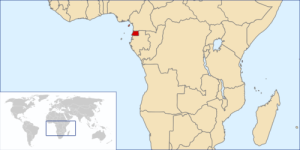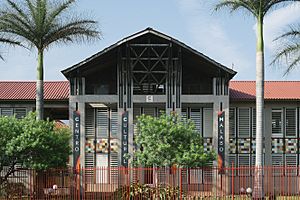History of Equatorial Guinea facts for kids
The history of Equatorial Guinea is a story of many changes. For centuries, different countries like Portugal, Britain, and Spain ruled this land. There were also local kingdoms before the Europeans arrived.
Contents
Early History
The first people in what is now Equatorial Guinea were likely the Pygmies. Today, only a few Pygmy groups remain in the northern part of Río Muni. Later, between the 1600s and 1800s, Bantu groups moved into the area. This included the Fang people. Some historians believe the Bubi people, who live on Bioko island, also came from Cameroon and Río Muni in waves.
Igbo slave traders from Nigeria also set up small communities on Bioko and in Río Muni. These grew into parts of the Aro Confederacy in the 1700s and 1800s. The people of Annobón island originally came from Angola. They were brought there by the Portuguese through São Tomé.
Colonial Times
Portuguese Rule (1472–1778)
A Portuguese explorer named Fernão do Pó was looking for a way to India. In 1472, he discovered the island of Bioko. He called it Formosa, meaning "Beautiful." But soon, it was named after him, "Fernando Po." Portugal took control of Fernando Po and Annobón islands in 1474.
In 1778, the queens and kings of Portugal and Spain signed an agreement. This agreement gave Spain control of Bioko island, nearby small islands, and trading rights in the Bight of Biafra. Spain wanted to start slave trading in the area. For many years, from 1778 to 1810, the territory was managed by a Spanish government based in Buenos Aires.
From 1827 to 1843, the United Kingdom had a base on Bioko. They used it to try and stop the slave trade across the Atlantic. Later, this base was moved to Sierra Leone. In 1844, Spain took control again. The area became known as the "Spanish Territories of the Gulf of Guinea." Spain had not fully settled the large area it claimed. Meanwhile, the French were expanding their own territories. In 1900, a new agreement was signed in Paris. Spain ended up with only a small part of the mainland, Río Muni, which was about 26,000 square kilometers.
Spanish Rule (1778–1968)
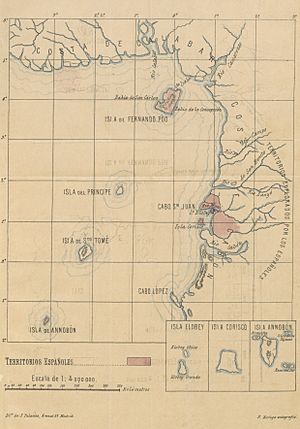
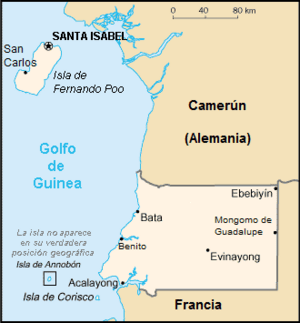

At the start of the 1900s, many large farms on Fernando Po were owned by a group of black Creole people called Fernandinos. The British had brought some people from Sierra Leone and freed slaves to the island. More people from West Africa and the West Indies also came. Some Cubans, Filipinos, and Spaniards were also sent there. Many Fernandinos spoke English and were Protestant. A simple form of English was the main language on the island.
During World War I, Spain remained neutral. This meant that many German soldiers and people seeking safety from German Kamerun came to Río Muni and Fernando Po. The Spanish treated them well because their small army could not force them to leave. Most Cameroonians stayed in Río Muni, while the Germans went to Fernando Po.
From the early 1900s, new Spanish settlers started to take over the farms. New land rules in 1904-1905 favored Spaniards. By 1940, it was thought that only 20% of the cocoa grown in the colony was still owned by Africans, mostly Fernandinos.
A big problem for the economy was a constant lack of workers. The local Bubi on Bioko island did not want to work on the large farms. They preferred to work on their own small cocoa farms. They were also protected by Spanish missionaries, who were very powerful in the colony. The missionaries helped the Bubi people, especially after two small uprisings in 1898 and 1910 against forced labor.
By the late 1800s, Spanish, Portuguese, German, and Fernandino farm owners started growing large amounts of cocoa. Since many local Bubi people had died from disease or forced labor, the island needed workers from other places. An agreement was made with Liberia in 1914 to bring up to 15,000 workers. However, this supply of workers stopped in 1930. An international group found that workers were being forced into labor in ways that were almost like slavery.
Between 1926 and 1959, Bioko and Río Muni were joined together as the colony of Spanish Guinea. The economy relied on large cocoa and coffee farms, and logging. Most workers were immigrants from Liberia, Nigeria, and Cameroon. Military actions were taken to control the Fang people in the 1920s. By 1929, the whole colony was considered 'peaceful'.
However, Río Muni had a small population, and it was easy for people to escape into Cameroon or Gabon. Also, timber companies needed more workers. Growing coffee also offered a way for people to pay taxes. So, Fernando Po still needed more workers. The main source of workers became Igbo people who were secretly brought by canoes from Calabar and Oron, Nigeria. By 1942, about 20,000 secret workers were on Fernando Po. A new worker agreement was signed that year. This agreement helped Fernando Po become one of Africa's most productive farming areas after World War II. By 1968, almost 100,000 Nigerians lived in Spanish Guinea.
Spanish Civil War (1936–1939)
When the Spanish Civil War began, the colony first supported the government. But on September 19, 1936, the Colonial Guard and Civil Guard started a rebellion. They took control of Fernando Po island. On October 14, a group of 200 rebels arrived and took control of Bata and the rest of the colony.
Becoming a Province and Independence
After World War II, the colony's political history changed in three main ways:
- Until 1959, it was just a colony. Then, it became a 'province' of Spain, like parts of Portugal's empire.
- Between 1960 and 1968, Spain tried to give it some freedom but still keep it as part of Spain.
- After 1968, the territory became an independent country.
In the first phase, Spain continued its old policies. Most people were treated as 'natives' without full rights. Only a small group, called emancipados, were given more rights if they adopted Spanish culture. The first local elections were held in 1959. Equatorial Guinean representatives were sent to the Spanish parliament. In 1963, the territory gained limited self-rule with a joint law-making body for its two provinces. The country's name was changed to Equatorial Guinea.
People started wanting independence during this time. Small groups who had fled to Cameroon and Gabon formed political groups. These groups pushed for change. The United Nations also put pressure on Spain. Finally, Spain agreed to independence. On October 12, 1968, the Republic of Equatorial Guinea became an independent country. Francisco Macías Nguema was elected as its first president.
Independence and Macias's Rule (1968–1979)
Quick facts for kids
Republic of Equatorial Guinea
|
|
|---|---|
| 1968–1979 | |
|
|
|
|
Anthem: Caminemos pisando las sendas de nuestra inmensa felicidad (Spanish)
Let Us Tread the Path of Our Immense Happiness |
|
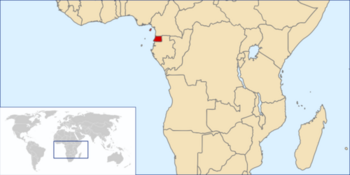 |
|
| Capital | Malabo |
| Government | Unitary presidential republic under an authoritarian dictatorship (until 1973) Unitary one-party presidential republic under a totalitarian dictatorship (From 1973) |
| President | |
|
• 1968–1979
|
Francisco Macías Nguema |
| History | |
| 12 October 1968 | |
| 12 October 1968 | |
|
• 1973 Constitution
|
29 July 1973 |
|
• 1979 Coup
|
3 August 1979 |
| Currency | Equatorial Guinean peseta Equatorial Guinean ekwele |
| ISO 3166 code | GQ |
| Today part of | Equatorial Guinea |

In March 1968, Spain announced it would give Equatorial Guinea independence. This was due to pressure from local leaders and the United Nations. A new constitution was created. On August 11, 1968, people voted for this constitution, and 63% said yes. It set up a government with a General Assembly and a Supreme Court.
In September 1968, Francisco Macías Nguema was elected the first president. Independence was granted in October.
At independence, Equatorial Guinea had a high income per person in Africa. However, this money was not shared equally. Most of it was held by colonial rulers and rich farm owners. The Spanish government had helped many people learn to read and write. They also built good health care centers. But when the country became independent, there were very few African doctors or lawyers.
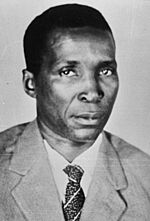
In July 1970, Macias made the country a single-party state, meaning only one political party was allowed. By May 1971, he changed important parts of the country's laws. In 1972, Macias took full control and became President for Life. His rule was known for harsh treatment of people and a government that controlled everything. This led to many people dying or leaving the country. About one-third of the population was affected.
Because of theft, lack of knowledge, and neglect, the country's basic services like electricity, water, roads, and health care fell apart. The economy was ruined. Many Nigerian workers on Bioko, estimated at 60,000, left in early 1976. The economy collapsed, and skilled citizens and foreigners left.
Religion was suppressed, and schools were closed in 1975. Churches were also closed in 1978. Macias started a campaign to use local names. The capital, Santa Isabel, became Malabo. The main island, Fernando Po, was renamed Masie Nguema Biyogo after himself. Annobón became Pagalu. He also ordered everyone to change their European names to African ones. His own name changed several times. Many people living on Bioko island, including Nigerian workers and traders, were forced to leave.
In August 1979, Macias's nephew, Teodoro Obiang Nguema Mbasogo, who was also a former director of the famous Black Beach prison, led a successful takeover. Macias was arrested, put on trial, and executed. Obiang became president in October 1979. The islands were renamed Bioko and Annobón. The new leader faced a huge challenge. The country was in ruins, the government had no money, and the population was much smaller than at independence.
Obiang's Rule (1979–Present)
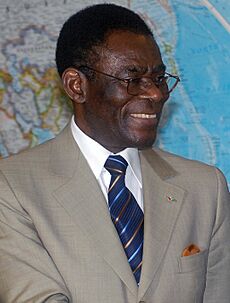
Since 1997, the country has found a lot of oil. This has caused big changes. According to a 2004 report, politics in the country are often shaped by disagreements between Obiang's son, Teodorin, and other close relatives who hold powerful positions in the security forces.
In 2004, there was an unsuccessful attempt by European and South African mercenaries to overthrow Obiang. This event was called the "Wonga Coup." The plan was to replace Obiang with a leader who would let the plotters control the country's oil wealth. Simon Mann, a former soldier, led the plot. It also involved former members of a South African army unit. Rich people, including Sir Mark Thatcher, the son of former British Prime Minister Margaret Thatcher, helped pay for the failed coup. Millions of dollars were spent on this attempt.
In 2011, the government announced plans for a new capital city. It was first called Oyala, but later named Djibloho – Ciudad de la Paz (City of Peace).
|
See also
 In Spanish: Historia de Guinea Ecuatorial para niños
In Spanish: Historia de Guinea Ecuatorial para niños


